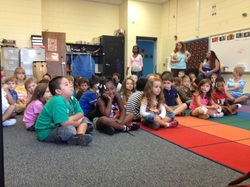
But that was nothing compared to the general attitude I encountered when the teachers lined them up for the opportunity to actually play on a real cello.
Shouts of encouragement for the current player erupted from the kids still in line .
"Wonderful!" and "You sound like a true professional!" were a few of my favorites. But this one took the cake: "Encore!" accompanied by the helpful explanation, "That means 'play it again!'"
I am sure some other comments escaped my attention since I was occupied with watching and guiding each player, one at a time. There was no violent pizzicato or tossing of the instrument to worry about this time, but, as the eager students drew ever closer to the current cellist, the wild bowing would sometimes get dangerously close to becoming a painful stab in a child's thigh. Probably ten times, we had to yell at them to step back, but there was no stopping this excited mob. They kept crowding in.
The best part of the whole visit was when several of the children sat down to play the cello, scratched a few jauntily angled bow strokes across the open G string, and exclaimed, "I am so good at this!"
Okay, so I know what you're thinking: there is no way those kids were any good. At all.
Well, they definitely nailed one critical component. They had the right attitude. And I am not talking about "being positive." That is not necessarily a great tool for learning how to become a musician.
What I am saying is that they had no preconceived notions of perfection stopping them from taking on a challenge. And because they lacked the awareness of their inexperience (or perhaps, as a kindergartner, most everything is a new experience and they have gotten used to the feeling of simply jumping into unfamiliar territory), their positive introduction might be enough to inspire them to take the next step.
We could all use a lesson in being like children again and learning how to be okay with starting from zero.
"Starting from Zero" is the title of Beth Bultman's article in the most recent Scor! newsletter about an effective sight-reading strategy (find out more about Scor! at http://stringcamp.com/). For your convenience, I have reprinted it here:
STARTING FROM ZERO
Sight-Reading Strategy When we sight-read, many of us make the mistake of starting with a standard of perfection, then “take points off” when we don’t get everything right. Although this is a common grading tool in school, starting at 100% then taking off points when the wrong answer is found on the test, it is not a productive approach when sight-reading.
Try this instead. Start from 0. Really. Because you’re sight-reading, remember? You’ve never seen this music before. So, you really are starting from 0.
Now, focus on the pulse. (Not the notes.) Can you feel the pulse? Follow the pulse? Keep your place in the music? (Good – you’re not at 0 anymore.) Now for rhythms – fit them into the larger pulse. (If you have trouble and are practicing on your own, try just counting, just clapping, just bowing in the air, or bowing on an open string.) Good – a few more points. (Pat self on back.)
Now for the notes - get as many as you can. Each note you play accurately is an additional accomplishment – you are building up from 0 by adding all these notes!
Remember, as you add things like bowings, articulation, and dynamics, you are adding the finishing touches to your sight-reading. These are certainly not the most important, but are great if you can get them in. A few more ways to inch your way up.
Sight-reading isn’t nearly as foreboding when you start from 0 and build up, rather than the more common top-down approach. Consider, by this point, how far you have come from the 0 you started at, and celebrate!
-Beth Bultman
This approach can be useful in many more situations besides sightreading, I am sure.
I was researching the Alexander Technique a few weeks ago and found an article comparing it to learning how to play the violin. The question the author was addressing was, "How long does it take to learn the Alexander Technique?" (Read the whole article here: http://alexandertechnique.com/articles2/howmanylessons/.)
She said that one can never stop learning--just as it is with the violin (or cello). The learning process is life-long.
She also admitted that the answer, "forever" was extremely unsatisfying, so she offered another approach:
"As soon as we know that if we pluck or draw a bow across the string of the violin, and that we can change the note by changing the length of the string, we can play the violin. Everything else is refinement."
So, those kindergartners really did have the right idea, wild bow angles and all. They were amazing!
Just because they started from zero.

 RSS Feed
RSS Feed